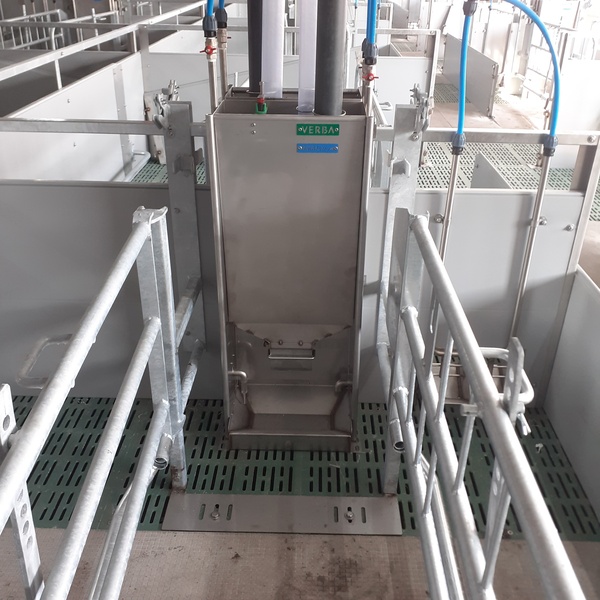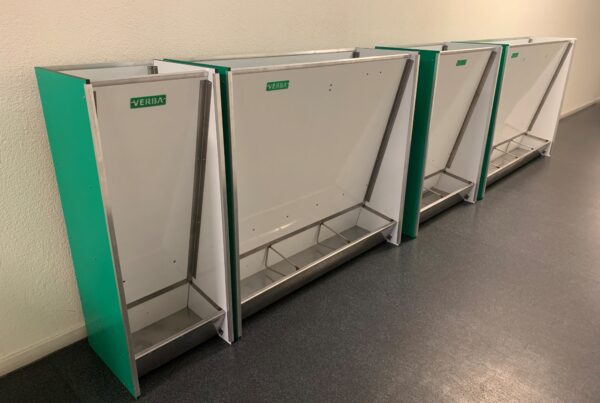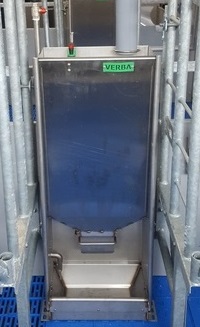Source: PigBusiness
Text: Reinout Burgers
Chances are that free-range farrowing pen pens will become the norm, but there is still little experience with free-range farrowing pen pens. Reason for WUR and VKON to organize a roadshow at pig farmer Jarno Brummelhuis. One striking aspect: Topigs achieves on their experimental farm in Canada a low dropout rate without tethering the sows.
Few sow farmers have free-range farrowing pens. This is partly because there is little investment because of laborious permit applications, but also because there is no binding legislation yet requiring such a farrowing pen system. That may change in the future now that the EFSA (European Food and Safety Authority) also embraces no-tethering. In any case, the fact that there are few free-range farrowing pen pens is not due to lack of interest from pig farmers.
At the roadshow at Jarno Brummelhuis in Hoge Hexel (OV), single pig farmers were present, a few of whom had experience with free-range farrowing pen pens. Due to great interest, VKON is going to organize a second roadshow on free-range farrowing pen pens. The roadshows are part of the Kennis op Maat project "Roadshow Profit of a well-designed activity area for pigs" and are being pulled by WUR and VKON.
WUR researcher Marko Ruis is closely involved in the road shows, and he sees that there is a lot of international attention on free-range farrowing pen pens. "This could indeed just become legislation and it is good that pig farmers are already working on this. In any case, what Jarno has here is a very nice concept."
Simple in design
Topigs Norsvin subbreeder Jarno Brummelhuis now has more than a decade of experience in free-range breeding pens. On his farm he has 530 breeding sows, with which they breed TN50 and TN70 breeding gilts. He uses the week system and has been weaning at 5 weeks of age for a year. The pregnant sows enter free-range farrowing pens just before the expected farrowing date and leave after 5 weeks (at weaning), while the weaned piglets remain in the pen. So for the piglets, little changes. "The free-range farrowing pen rearing pen has been extensively tested at our facility and is simple in design. It was conceived by the farmer and looked at from the animal's point of view," Brummelhuis told pig farmers.
"For me, the success of free-range farrowing pen rearing pens is simplicity. the overview during inspections, ease of work, feeding by allowing piglet and sow to eat together, no growth check, less rinse water, lower heating costs and, of course, animal welfare. Piglet and sow can now better exhibit their natural behavior. Requirements, however, are a calm sow with good and strong legwork, giving her the strength to lie down quietly and not flop down, and of course robust smooth piglets."
Testing clearance
The first free-range farrowing pens Brummelhuis tested on his own farm were the Pro Dromi farrowing pens, but because nannies did not fit into the farrowing concept, the pig farmer developed his own free-range farrowing pen. In the test pen with six farrowing pens, he tested different setups for two years starting in 2014. During those two testing years, Brummelhuis worked with Nijenkamp and others to improve the free-range pen, and now there is a system that works well in practice and has been stripped of all unnecessary items. December 2016 saw the opening of the new free-range farrowing pen rearing stable with 11 sections and 22 pens per section.
Brummelhuis: 'On Wednesday we spray clean the farrowing pens and on Thursday we put up 22 sows. anden we put up a new line and put up the sows in a pen of 22 sows. This is done very quietly and with all 22 sows at the same time. The fences are easy to operate. On Monday we lay the sows temporarily and the ward temperature is then 22 degrees Celsius. During the week, the piglets are born. On Thursday, when the last piglets are born, we lower the temperature to 19 degrees Celcius. Five to seven days after birth, the sow may be released. The piglets are safe in the piglet nest until then. The piglets and the sow like to be together, which is why the piglet nest is placed near the sow's head."
The innovative subbreeder had initially released the sows after single three days, but then found that the failure rate was slightly higher as a result, so he is now leaving them tied down a little longer.
"The failure rate at our place is similar to the old situation and other stalls."
An important aspect of free-range farrowing pen pens is the interaction between sow and piglet, which allows them to exhibit more natural behaviors such as learning to eat. "You see that when the sow eats; then the piglets want to eat too," the subbreeder points out. "They do that after single three days. We therefore very consciously chose the low VERBA KZB family feeders. The waste of feed is minimal, according to research in the manure pit on feed residues."
With a high feeder, there is more spillage because the sow wants to give the feed to the piglets out of natural instinct and she pushes the feed over the feeder edge.
Eating behavior free-range farrowing pen
Brummelhuis is not the single speaker at the Roadshow. Anouschka Middelkoop, Swine Nutrition researcher at Schothorst Feed Research (SFR), will explain about the free-range farrowing pen pens at SFR and then about "eating together, learning together" to the eating behavior of piglets in free-range farrowing pen pens. At SFR, the sow remains fixed for about four days after birth, using a balance floor under the sow. This rises when the sow stands up.
"After switching to free-range farrowing pen housing with a balance floor, we saw a reduction in the death rate, from 6 to 4.3 percent, and were able to reduce mortality in the farrowing pen. We wean alternately at 30 days, after which the go to the weaning pen. Unlike Brummelhuis, we use high feeders. This is because we want to know and measure what the piglet eats and what the sow eats, since we are a research farm. However, free-range farrowing pen pens offer many additional opportunities for piglets to learn eating by the sow. There are also more uses for offering different types of feed."
Middelkoop continues her story "In nature, we see that piglets start foraging and exploring on day 5. By day 10, piglet and sow are already eating together and the piglets learn from the sow what, where and how to eat. You can implement this in the farrowing pen using a family eating system, for example by feeding the sow in a low feeder." With a family eating system instead of a high feeder, Middelkoop says you have more opportunities for the piglet to see what and how the sow is eating. "A piglet is more likely to eat when the other pigs are at the feeder. Moreover, the piglet wants to eat the same food as the others. Therefore, in studies with a family eating system, 73 percent of piglets learn to eat before weaning, and they learn this particularly at a younger age. This can lead to higher feed intake and growth."
Better digestion and efficiency
By starting early to offer solid feed to lactating piglets, not single do they have time to learn to feed from the sow, but also the gut has time to develop properly and adapt to this nutritional change. It is therefore important to provide the same piglet feed around weaning, because the piglet and gut package is used to this. Middelkoop "That piglets additionally eat sow feed is not a bad thing at all. It is even an advantage, because because because they eat sow feed the intestinal villi become longer and therefore the intestinal surface area is larger. Because of the larger intestinal surface, there is better digestion and efficiency.
In addition, Middelkoop's doctoral research showed that by offering multiple types of feed, you can increase piglet feed intake. By giving piglets the opportunity to eat from the lacto feed with the sow, in addition to passing piglet feed in their own bowl, the total solid feed intake will be higher. This ensures a good start after weaning, and sometimes even a higher weaning weight. In addition, to get piglets to eat, it is important that the feed is provided fresh, large chunks of piglets can help to master this motorically, and it can help to offer the feed wet first.
Brummelhuis largely follows the same principles as Middelkoop. For example, the VERBA family feeder (KZB) is accessible to the piglets on because it is on the floor, and the piglets are given a small trough with the same piglet feed after 5 days as they are given after weaning. In the pig farmer's experience, the piglets grab the large pieces from the feeder first. Because the piglet and sows clean the VERBA family feeder themselves, the piglets always have fresh feed.
Motherhood
Genetics and free-range farrowing pen breeding belong together a bit, because precisely because the sow is free-running, she should be calm and have good mothering characteristics. That is what breeding organizations can select for. At its new innovation center in Canada Innova, Topigs Norsvin is conducting research on free-range farrowing pen pens. Why? The breeding organization is convinced that the free-range farrowing pen pen will be the future and will be enshrined in legislation. "We always breed with an eye on the future," says Lisette van der Zande, researcher at Topigs Norsvin. "Because breeding takes time. That also means looking at what the legislation will do in terms of animal welfare and responding to this with our genetics. So we are also researching the use of free-range farrowing pen pens and in Canada we have the Prodromi. I study the behavior of piglets and sows in the free-range farrowing pen pens and the risk of higher failure rates. Sometimes we have the sows loose after a day or we don't confine them at all. Thereby, the interaction between piglet and sow is important. Why can there be a higher dropout rate? It can be due to a clumsy sow, but it can also have to do with the vitality of the piglets. We can select on the breeding value maternal traits." Cameras are hanging in Canada to monitor the behavior, which the Topigs Norsvin researcher can view at any time in the Netherlands. The research is aimed at selecting genetics and taking the data into breeding programs. What Van der Zande sees in the free-range farrowing pen pens is that the higher the breeding value maternal traits, the lower the piglet mortality. "We see that effect especially in the free-range farrowing pen pens and not in the standard pen. The mortality in the free-range farrowing pen pens is now at the same level as that of the standard pens. With the cameras we record the interaction between piglet and sow. How often, where and what. This allows us to steer extra on behavior with the goal of reducing dropout. However, we have been selecting on mother characteristics for years, but in a free-range farrowing pen stable that is extra important."
Belly sleepers are deadbeats
Yet the research is already showing other encouraging results. 'We see that the sow's posture predicts whether there will soon be a high or low dropout rate. Sows with one or more deadbeats appear to lie more on their bellies. Why? Perhaps something to do with the legwork or udder. In fact, if they have udder infection, they also tend to lie on their bellies. We could tell this before farrowing and could be used as a management tool. Also, it is mainly the small piglets that drop out."
Interestingly, Brummelhuis had more or less the same experience. Sows that have a high failure rate in a conventional farrowing pen were also found to have a higher failure rate in free range, and vice versa. Perhaps genetics does have an important influence on dropout after all than just the farrowing pen system. For Brummelhuis, the free-range farrowing pen is surely the ideal farrowing pen. "At least for us. The key figures are the same as in the old situation and it is a lot more relaxed working. The failure rate always remains a point of attention and we therefore select our sows on this as well."




